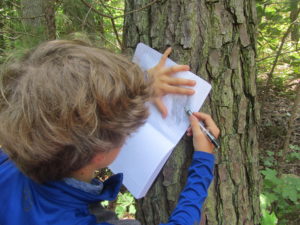Observation-Focused Nature Journaling

To view the photo-rich magazine version, click here.
Originally appears in the Fall 2017 issue
by Danae Shipp
On fall and spring Fridays during our forty-minute science class, my students are sprawled out on the grass, armed with a pencils and composition notebooks, ready to observe the beauty of nature. This is our nature journaling time, during which I am hoping to foster future naturalists.1 I want my students to slow down and purposefully observe familiar nature objects such as pinecones, rocks, grass, and ants to awaken their senses, help them see the world more scientifically and stimulate curiosity. By focusing on journaling for observation development, they suddenly notice the beauty in the seemingly mundane, viewing details they may not have noticed before such as the grooves in a rock, the number of veins in a particular leaf, or the behavioral patterns of a bird.
While nature journaling is often advertised as a creative, fluid process where the main goal is artistic expression, observation-focused journaling requires students also to think scientifically and provide reliable documentation of their subjects; this requires them to notice their subjects on a deeper level by using all of their senses and discerning subtle differences.1, 2 However, the ability to thoughtfully express observations about the natural world with thoroughness and accuracy is not innate to most people.1 If we want to avoid having our students just take cursory glances at objects and report a few facts, then we must educate them about what it means to truly observe. This means taking the time to teach the difference between inference and observation, the importance of using all of their senses, and the significance of making both quantitative and qualitative observations. Nature journaling is the perfect way of practicing these concepts as it forces observers to gather information that might otherwise be overlooked.
To develop their observation skills, my students are assigned different entries to focus their exploration efforts. For example, the first journal entry my students complete is a way of immediately gauging their descriptive writing abilities and observation skills. Students observe a natural object (e.g., a plant) with which they are unfamiliar, and describe that object so well that when another classmate reads their observations (and sees their sketch), the classmate can identify their object. When they switch journals, students get immediate feedback on their strengths as a writer and observer, and then they know upon which areas they need to work.
This content is restricted to subscribers only.
If you are not yet a subscriber, please consider taking out a subscription here.
If you are an existing subscriber, kindly log in or contact us at info@greenteacher.com for more information.





